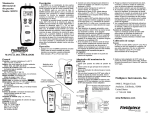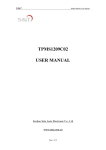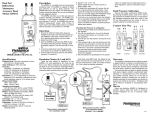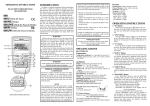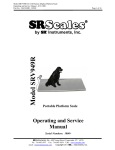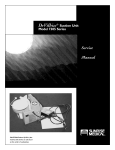Download SDMN6 - Fieldpiece Instruments
Transcript
Fieldpiece Quick Start 1. Press Dual Port Manometer and Pressure Switch Tester Description for 1 second to turn on your SDMN6. 2. If necessary, press ZERO for 1 second to set the ambient pressure of P1 and P2. 3. P1 will be displayed in inches of water column (inWC.) P1-P2 will be displayed on lower line. 4. See sections below for details on testing pressure switches. OPERATOR'S MANUAL Scan for Video Model SDMN6 CertificationsGet the free mobile app at http:/ / gettag.mobi C-Tick (N22675) CE 01 03 Leads Detect Continuity P1/P2 Mode: P1-P2 Test Mode: Shows when you are Increasing (InC) or Decreasing (dEC) pump speed. Solid: Readings Held Blink: Auto-Capture Mode Pump Speed Limit Reached Low Battery Indicates Whether P1 or P2 is Shown on Top Display Line Controls Hold for one second to toggle power. Press to toggle backlight. HOLD the displayed measurements. In TEST mode: press to activate auto-capture mode. The pressure reading will automatically HOLD when the pressure switch closes or opens. Hold for one second to zero pressure of P1 and P2. Enter pressure switch TEST mode and start the pump (allow warm up to finish). Press again to stop the pump and return to P1/P2 mode. Select P1 or P2 on top display. (Hold while powering ON to disable Auto-off.) In TEST mode, increase pump speed (InC) to increase the induced vacuum. (Holding increases faster.) Select mbar, inWC, mmWC, or psi. (Hold to check % battery remaining.) Decrease pump speed (dEC) to decrease the induced vacuum. (Holding decreases faster.) 4. You can press P1 / P2 to toggle the top display between P1 and P2. Note: P1 - P2 is shown in the bottom line of the LCD. 5. Press UNITS to select: inches of water column (inWC), millimeters of water column (mmWC), millibar (mBar), or pounds per square inch (psi). 6.Your SDMN6 will turn off automatically after 15 minutes of inactivity if APO is shown. To disable auto-power-off (APO) hold P1/P2 while turning on your SDMN6. 7. If you are in an environment where the temperature is noticeably changing while you are taking your reading, it is advised that you disconnect the meter from the hoses and ZERO it relative to ambient before each reading. P2 inWC Gas Pressure Blower PUMP 05 >> AIRFLOW DIRECTION >> 0.05inWC P1 04 NOTE: Always use the static pressure probes if checking static pressure of an airflow stream. NOTE: The red arrows on the probes should point toward the airflow stream. 1. ZERO your SDMN6 while at ambient pressure with any hoses/probes attached. This will zero both P1 and P2. For measurements less than 2 inWC, take reading within 1 minute after zeroing for best accuracy. 2. Use one hose (P1 or P2) to get the gauge pressure relative to the ambient or ZERO pressure. 3. Connect both hoses if you want to see relative pressure, P1 - P2. This is common when evaluating equipment such as a blower. 07 Blinks When Pump is ON RoHS Compliant Static Pressure Storage temperature: -4°F to 140°F (-20°C to 60°C), 0 to 80% RH (with battery removed) Power: 9V, NEDA 1604A, IEC 6LR61 9V alkaline battery. Battery life (alkaline): 200 hours (manometer only, backlight off), 12 hours (pressure switch testing @ 27% pump speed, BL off, approx -2.5"WC induced pressure w/o pump bleed accessory) Auto power off (APO): 15 minutes Low battery indication: Units of Measure: inWC, mmWC, mbar, psi Resolution: 0.01 inWC Overrange: “OL” or “-OL” is displayed Max Pressure: 900inWC (17.4psi) will damage sensors Compatible media: Dry, non-corrosive gases Pressure ports: 2 connectors (P1, P2) for flexible tubing (4.5mm to 8mm ID) Pump port: 1 connector (PUMP) for 5mm (~3/16 inch) ID flexible tubing Lead jacks: 2 banana plug jacks for testing open/close switch status (continuity between terminals) Accuracy: Stated accuracy at 0 to 50°C (32 to122°F): ±1.5% FS Accuracy and ranges: inWC: ±0.02 on 0.00 to ±2.00 (±1.5% FS on 2.00 to ±60.0); mmWC: ±0.5 on 0.00 to ±51.0 (±1.5% FS on 51.0 to ±1500); mbar: ±0.05 on 0.00 to ±5.00 (±1.5% FS on 5.00 to ±150.0); psi: ±0.001 on 0.000 to ±0.07 (±1.5% FS on 0.07 to ±2.000) Real Time Pressure Measurement of P1 or P2 (mbar, inWC,mmWC, or psi) Auto Power Off (APO) Enabled WEEE 02 Specifications Operating environment: 32°F to 118°F (0°C to 48°C) at <80% RH 06 Display Correct pressure switch operation is integral to the safety of a furnace environment. The SDMN6 is a dual-port manometer that also accurately tests pressure switches by simulating a draft with an internal pump. Adjust the pump's speed to create a negative pressure (vacuum). The red LED indicates when the switch closes. View the closing/opening pressures directly on the LCD. The dual-port manometer measures ±60 inches of water column, high enough for gas pressures. Check building pressurization with static pressure resolution of 0.01"WC. View P1-P2 in the bottom line of the display for checking pressure differentials. Use the static pressure probes to check for a pressure drop accross two points in a duct. This is useful for evaluating a blower or finding airflow restrictions in the ductwork. -0.03inWC 08 P1 Gas Manifold Adapter (5/16” to 3/16”) Adapter Tube (5/16”) Outlet Pressure Tap Screw PUMP P2 inWC Smaller end (3/16”) of the adapter connects to SDMN6 tubing. Remove the installed brass screw fitting from tube so the adapter can be inserted. Inlet Pressure Tap Screw Inlet Pressure Tap Outlet Pressure Tap 09 10 1.See manufacturer's specification for target inlet and outlet pressures. 2. Shut off main gas supply to furnace. 3. Shut off power to furnace equipment. 4. Zero your SDMN6 while at ambient pressure with hoses attached. 5. Remove outlet pressure tap screw, and insert the brass screw fitting of the P1 hose into the outlet pressure tap of the gas regulator. NOTE: Some pressure taps have a 5/16" boss instead of an insert screw. In this case, remove the brass screw fitting from the P1 hose and connect the included 5/16" adapter tube. Loosen the tap screw about 1 revolution, and slide the tube over the boss (see illustration at left). Make sure the tube is over the boss enough to prevent leakage. 6. Put furnace into operation (i.e. turn on gas and power to the furnace, call for heating, and have furnace ignite as if running it in normal operation). 7. P1 will show the pressure coming out of the regulator. 8. If you suspect high or low inlet pressure into the regulator, connect P1 to inlet tap and P2 to outlet tap to see the pressure drop across the regulator. Pressure Switch Test N.O. COM NEG P1 11 PUMP P2 WARNING: Read "Pressure Switch Testing Safety Info" section below prior to testing. 1. Connect leads (interchangeable) from the SDMN6 to the N.O. (normally open) and COM (common) terminals of the pressure switch. 2.Connect the 2 yellow hoses of the Y-splitter to the P1 and PUMP ports of your SDMN6. 12 Transducer Test Pump Bleed AccessorY Most pressure switches have a bleed port to help regulate the pressure required to close and open the switch. Pressure switches rated around -0.10inWC often don't have a bleed port. You can insert the Pump Bleed Accessory directly onto the PUMP port to give the pump better control of these low negative pressures. 17 The pressure switch is a safety device that prevents the furnace from running in an unsafe condition. An unsafe condition can result in injury, loss of property or even loss of life. 1. Before every use, check the SDMN6 and the tubing for breaks or blockage. Check the tubing for any moisture as well. 2. It is critical that the hoses going to P1 and the switch are the same length. 3. Check for the presence of moisture in the pressure switch before using the SDMN6. Do not use the SDMN6 on a pressure switch that has moisture in it. Moisture can damage the SDMN6 and VOID the warranty. Check the tubing for moisture build-up as well. 4. The SDMN6 is designed to produce a precise amount of negative pressure. Always zero the SDMN6 before testing a switch. 5.Fieldpiece is not responsible for incorrect readings by faulty test equipment or untrained personnel. 6. In the interest of safety, the SDMN6 should only be used by trained, competent professionals who understand the hazards and If you have difficulty maintaining the correct pressure to open and close the switch the diaphragm could be cracked. Pressure readings are greatly affected when the hose to the pressure switch is pinched. If the pressure does not change when you pinch the hose on a pressure switch with a bleed port, the bleed port could be blocked. Examine the bleed port for signs of corrosion or debris. Corrosion is a sign that the switch has been exposed to excessive moisture and diaphragm could be coated with debris. Checking the Inducer To Pump Port If the pressure created by the inducer measures more than enough to close the pressure switch, but the SDMN6 proves the pressure switch to be good, the inducer may not be providing enough airflow to close the switch. Indications a pressure switch is out of calibration, has a weak/bad diaphragm, or a bad micro switch in the pressure switch: • Closing/opening outside the manufacturer's tolerance rating. • CLOSED LED blinks rapidly. • Dramatic fluctuations of pressure readings. 14 ! WARNINGS 15 For Service Limited Warranty consider the risks of working on and with tools and equipment. 7. The pressure rating for the pressure switch is either stamped on the pressure switch or on a sticker attached to the pressure switch. Otherwise, contact the vendor or manufacturer of the furnace to get that information. 8. An adjustable pressure switch must open at the desired negative pressure to match the one it is replacing. 9. Fieldpiece is not liable for any damages, injuries, or loss of life incurred by the misuse of the SDMN6. NOTE: Pressure switch ratings are noted by “[pressure] PF”. This means that the circuit opens when the switch senses its rated Pressure Fall. Example: A -0.40" WC PF rated switch should open at a negative 0.40 inches of water column. The pressure switch should close and more importantly “open” within the manufacturer’s tolerance rating. WARNING: Read "Pressure Switch Testing Safety Info" section below prior to testing. 1.Follow steps 1-6 of "Pressure Switch Test". 7.Press / to adjust the pump speed until displayed negative pressure is stable, within ±0.02 inWC of your target pressure. 8.Start with the switch closed. If the switch is open, slowly loosen the adjustment screw until the CLOSED LED turns on. 9.Open the switch by slowly tightening the adjustment screw on the adjustable pressure switch until the CLOSED LED turns off. The adjustable pressure switch is now calibrated to your target pressure. NOTE: Stabilized pressures may slightly fluctuate after an adjustment. Be sure to adjust the pump speed ( / ) as needed to maintain the desired induced negative pressure. NOTE: Dual-pressure switches only have one spring and one diaphragm so it's only necessary to test the negative side. Checking the Bleed Port To Yellow Pump Hose 13 Adjustable Pressure Switch Calibration Checking the Diaphragm AUTO CAPTURE MODE Press HOLD to automatically HOLD a closing or opening pressure of a switch as you change the speed of the pump. "HOLD" blinks until a change in continuity is detected. Press HOLD again to exit AUTO CAPTURE mode. Pressure Switch Testing Safety Info 1. Connect the 2 yellow hoses of the Y-splitter to the P1 and PUMP ports of your SDMN6. 2.Connect a volt meter to the transducer's terminals. 3. ZERO your SDMN6 while at ambient pressure with yellow hoses attached. For measurements less than 2 inWC, take reading within 1 minute after zeroing for best accuracy. 4.Press TEST to start the pump. A brief warm up period ensues. 5.Now connect the white hose to the low side of the transducer. (Incorrect setup will cause incorrect pressure measurements.) 6.Press / to increase/decrease the pump speed and resulting negative pressure. For higher rated transducers, you can hold down the button to get the pump up to speed faster. 7. As you increase the negative pressure, the voltage across the terminals will change based on the transducer's rating. Compare observed voltage to rated voltage to determine the health of the transducer. 16 3. ZERO your SDMN6 while at ambient pressure with yellow hoses attached. For measurements less than 2 inWC, take reading within 1 minute after zeroing for best accuracy. 4. Press TEST to start the pump. A brief warm up period ensues. 5. Now connect the white hose to the negative side of the pressure switch. (Incorrect setup will cause incorrect pressure measurements.) 6. Make sure the pressure switch is vertically oriented, the same as it is on the equipment. 7.If the CLOSED LED is OFF, press to increase the pump speed and induce a negative pressure on the switch. The CLOSED LED will light when the pressure switch closes. Note the closing pressure. If the CLOSED LED is ON, press to slow the pump and decrease the negative pressure on the switch. The CLOSED LED turns off when the switch opens. Note the opening pressure. NOTE: For higher rated switches, you can hold or to accelerate/decelerate the down pump faster. Slow your acceleration as you approach the switch's rated pressure. NOTE: A pressure switch should open and close within the manufacturer's tolerance rating of the switch (typically ±10%). This meter is warranted against defects in material or workmanship for one year from date of purchase. Fieldpiece will replace or repair the defective unit, at its option, subject to verification of the defect. This warranty does not apply to defects resulting from abuse, neglect, accident, unauthorized repair, alteration, or unreasonable use of the instrument. Any implied warranties arising from the sale of a Fieldpiece product, including but not limited to implied warranties of merchantability and fitness for a particular purpose, are limited to the above. Fieldpiece shall not be liable for loss of use of the instrument or other incidental or consequential damages, expenses, or economic loss, or for any claim of such damage, expenses, or economic loss. State laws vary. The above limitations or exclusions may not apply to you. In the USA, call Fieldpiece Instruments for one-price-fix-all out of warranty service pricing. Send check or money order for the amount quoted. Send the meter freight prepaid to Fieldpiece Instruments. Send proof of date and location of purchase for in-warranty service. The meter will be repaired or replaced, at the option of Fieldpiece, and returned via least cost transportation. Outside of the USA, please visit www.fieldpiece.com for service contact information. For international customers, warranty for products purchased outside of the U.S. should be handled through local distributors. www.fieldpiece.com ©Fieldpiece Instruments, Inc 2014; v14 ! Turn off power to furnace prior to testing to avoid low voltage shorting. 18 19 20



